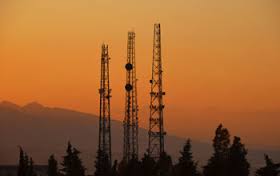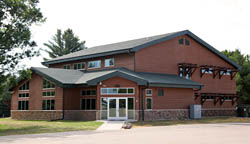Newsroom
Use the filters below to narrow publications by offices, programs or categories
 The United States is fast becoming a wireless nation. The demand for wireless devices in all sectors of our lives – from smartphones to smart utility meters – is driving the exploding demand for access to spectrum. By 2019, Cisco predicts there will be a seven-fold increase in data traffic.
The United States is fast becoming a wireless nation. The demand for wireless devices in all sectors of our lives – from smartphones to smart utility meters – is driving the exploding demand for access to spectrum. By 2019, Cisco predicts there will be a seven-fold increase in data traffic.
By Lawrence E. Strickling, Assistant Secretary of Commerce for Communications and Information and NTIA administrator, and Alexander Macgillivray, U.S. Deputy Chief Technology Officer, White House Office of Science and Technology Policy
Today, I’m happy to recognize a number of NTIA employees who received Department of Commerce Gold and Silver awards for their outstanding contributions. Deputy Secretary of Commerce Bruce Andrews presented the awards at a special ceremony today.
Over the past five years, we at NTIA have seen first-hand through our broadband grant program the power of broadband to transform lives and impact communities. Broadband has become a cornerstone of economic growth, providing Americans the tools they need to participate in the rapidly growing digital economy.
In the summer of 2010 -- just three years after the introduction of the iPhone -- President Obama called on the National Telecommunications and Information Administration (NTIA) to collaborate with the Federal Communications Commission (FCC) to free up critical radio spectrum to fuel the breakneck growth of the wireless broadband market.
This post is part of our “Spotlight on NTIA” blog series, which is highlighting the work that NTIA employees are doing to advance NTIA’s mission of promoting broadband adoption, finding spectrum to meet the growing demand for wireless technologies, and ensuring the Internet remains an engine for innovation and economic growth.
When Congress called for the creation of a nationwide broadband network for public safety in the Middle Class Tax Relief and Job Creation Act of 2012, lawmakers knew it was important that states play a key role in ensuring that the network meets the needs of local first responders. To implement this goal, the law directed NTIA to establish the State and Local Implementation Grant Program (SLIGP) to support states as they prepare for the launch of the network.
This blog was cross posted on the Commerce.gov website.
One of the core functions of the National Telecommunications and Information Administration (NTIA) is to manage federal uses of wireless spectrum to make the most efficient use of this precious resource. It’s complex, technical work performed by a team of resourceful engineers who labor behind the scenes to ensure that federal agencies have the radio spectrum they need to perform all sorts of mission-critical functions.
This post is part of our “Spotlight on NTIA” blog series, which is highlighting the work that NTIA employees are doing to advance NTIA’s mission of promoting broadband adoption, finding spectrum to meet the growing demand for wireless technologies, and ensuring the Internet remains an engine for innovation and economic growth.
Agencies across the federal government use spectrum to perform critical functions from predicting the weather to air traffic control. But they may not be as familiar with NTIA’s role in this process and how we ensure agencies have the airwaves they need to carry out critical missions for the American people.
Today we are celebrating International Internet Day, which marks the first message ever sent over the Internet 45 years ago. At NTIA, one of our main jobs every day is to maximize the societal benefits made possible by the Internet through policies and efforts that expand Internet availability and adoption.
This post is part of our “Spotlight on NTIA” blog series, which is highlighting the work that NTIA employees are doing to advance NTIA’s mission of promoting broadband adoption, finding spectrum to meet the growing demand for wireless technologies, and ensuring the Internet remains an engine for innovation and economic growth.
You could say Lynn Chadwick’s career has come full circle.
The National Telecommunications and Information Administration (NTIA) last week hosted the second in a series of stakeholder workshops as we launch a new initiative to leverage the success of our Recovery Act broadband grant programs and support communities nationwide seeking to build their broadband capacity.
This post is part of our “Spotlight on NTIA” blog series, which is highlighting the work that NTIA employees are doing to advance NTIA’s mission of promoting broadband adoption, finding spectrum to meet the growing demand for wireless technologies, and ensuring the Internet remains an engine for innovation and economic growth.
Today, we are announcing the second in a series of workshops to share lessons we have learned from our broadband grants programs with communities nationwide seeking to build their broadband capacity.
“It’s been great seeing people come back and say, ‘I’ve been able to get a job,’ after we helped them with sprucing up their résumé and applying for jobs online.” - PCC Staff Member, Las Vegas Urban League
“Without this computer lab, we would not be getting people the jobs that we’re getting them. It’s just a great thing.” - Staff Member, Workforce West Virginia
This post is part of our “Spotlight on NTIA” blog series, which is highlighting the work that NTIA employees are doing to advance NTIA’s mission of promoting broadband adoption, finding spectrum to meet the growing demand for wireless technologies, and ensuring the Internet remains an engine for innovation and economic growth.
First responders know the deadly consequences of not having a communications network that is reliable and interoperable, a problem highlighted during the September 2001 terrorist attacks and Hurricanes Katrina and Sandy.
The U.S. Commerce Department’s National Telecommunications and Information Administration (NTIA) is working to ensure our nation’s first responders have access to the most advanced communications when responding to an emergency or natural disaster.
To support the Administration’s commitment to making available an additional 500 MHz of spectrum for commercial use by 2020, NTIA continues to perform and publish technical studies in bands proposed for sharing. In collaboration with a wireless technology provider, earlier this year NTIA performed ground-breaking interference-effects testing between radar signals and broadband digital communication receivers in the 3550–3650 MHz band.
Access to high-speed Internet has become a necessity for communities and businesses, and the latest data from the National Broadband Map shows that broadband continues to be available to more Americans than ever.
Broadband drives economic growth and innovation – including advances in health care, education, and public safety. Since its launch in 2011, the National Broadband Map has been helping businesses and consumers access broadband by detailing where and what types of high-speed Internet services are available in their communities.
Building on Administration efforts to make more spectrum available for commercial mobile broadband, NTIA and the Federal Communications Commission’s Office of Engineering and Technology (OET) today issued a Joint Public Notice seeking comment on the possibility of establishing a “Model City” for demonstrating and evaluating advanced spectrum sharing technologies.
This post is part of our “Spotlight on NTIA” blog series, which is highlighting the work that NTIA employees are doing to advance NTIA’s mission of promoting broadband adoption, finding spectrum to meet the growing demand for wireless technologies, and ensuring the Internet remains an engine for innovation and economic growth.
Three years ago this month, the Organization for Economic Cooperation and Development (OECD) endorsed a set of principles that encouraged its members to implement policies that call for a common approach to Internet policymaking that center on ensuring the openness of the Internet.
NTIA today released the Fourth Interim Progress Report on the Obama Administration’s initiative to identify and make available 500 megahertz of federal and non-federal spectrum for commercial wireless broadband use by 2020.

